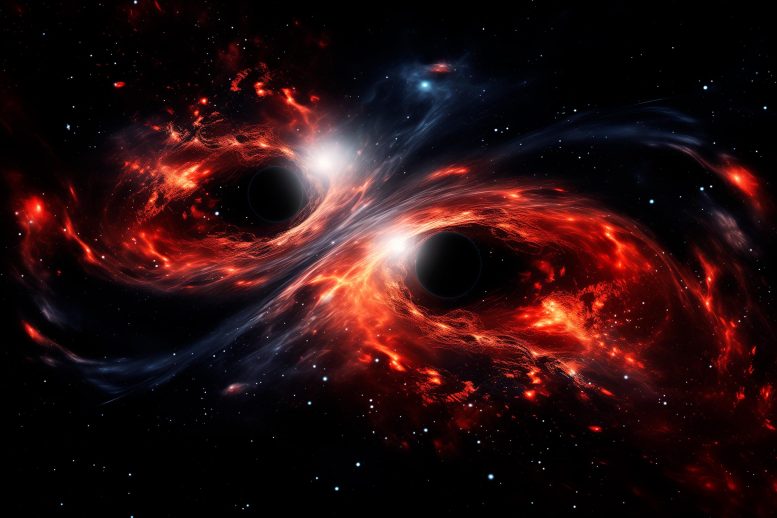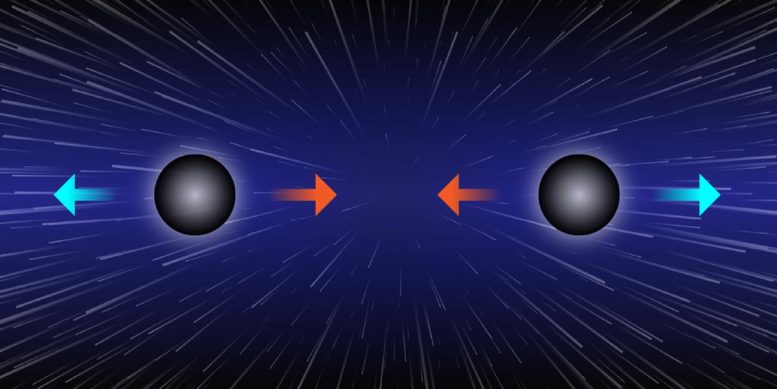
A new theory proposes that black holes can exist in balanced pairs, appearing as one due to a force called the ‘cosmological constant’. This force, combined with gravitational attraction, keeps the black holes at a fixed distance despite the Universe’s expansion.
Scientists theorize balanced black hole pairs can exist, appearing as one, thanks to the ‘cosmological constant’ balancing cosmic expansion and gravitational pull.
Researchers from the University of Southampton, in collaboration with colleagues from the universities of Cambridge and Barcelona, have shown it’s theoretically possible for black holes to exist in perfectly balanced pairs – held in equilibrium by a cosmological force – mimicking a single black hole.
Black holes are massive astronomical objects with such a strong gravitational pull that nothing, not even light, can escape. They are incredibly dense. A black hole could pack the mass of the Earth into a space the size of a pea.
The Role of Universe’s Movement on Black Holes
Conventional theories about black holes, based on Einstein’s theory of General Relativity, typically explain how static or spinning black holes can exist on their own, isolated in space. Black holes in pairs would eventually be thwarted by gravity, as it attracts them together until an ultimate collision.
However, this is true if one assumes the Universe is standing still. But what about one that is constantly moving? Could pairs of black holes exist in harmony in an ever-expanding Universe, perhaps masquerading as one?

Two black holes can be held at a fixed distance when their gravitational attraction (red arrows) is offset by the cosmic expansion (blue arrows) associated with a cosmological constant. Such a situation would mimic a single black hole for faraway observers. Credit: APS/Alan Stonebraker
“The standard model of cosmology assumes that the Big Bang brought the Universe into existence and that, approximately 9.8 billion years ago, it became dominated by a mysterious force, coined ‘dark energy’, which accelerates the Universe at a constant rate,” says Professor Oscar Dias of the University of Southampton.
The Impact of the Cosmological Constant
Scientists refer to this mysterious force as a ‘cosmological constant’. In a Universe explained by Einstein’s theory with a cosmological constant, black holes are immersed in a cosmological accelerated background. This moves the theoretical goalposts over how black holes can interact and exist together.
Through complex numerical methods, the team behind this latest study shows that two static (non-spinning) black holes can exist in equilibrium – their gravitational attraction offset by the expansion associated with a cosmological constant. Even in the acceleration of an ever-expanding Universe, the black holes remain locked at a fixed distance from one another. As hard as expansion may try to pull them apart, the gravitational attraction compensates.
“Viewed from a distance, a pair of black holes whose attraction is offset by cosmic expansion would look like a single black hole. It might be hard to detect whether it is a single black hole or a pair of them,” comments Professor Dias.
Professor Jorge Santos of the University of Cambridge adds: “Our theory is proven for a pair of static black holes, but we believe it could be applied to spinning ones too. Also, it seems plausible that our solution could hold true for three or even four black holes, opening up a whole range of possibilities.”
Reference: “Static Black Binaries in de Sitter Space” by Óscar J. C. Dias, Gary W. Gibbons, Jorge E. Santos and Benson Way, 25 September 2023, Physical Review Letters.
DOI: 10.1103/PhysRevLett.131.131401
This study was conducted by Professor Oscar Dias (University of Southampton), Professor Gary Gibbons (University of Cambridge), Professor Jorge Santos (University of Cambridge) and Dr. Benson Way (University of Barcelona).









Back in the day when the entire universe revoled around the Earth, mathematics explained everything so beautifully, unfortunately, once again it appears that someone has an intense hidden agenda as to why the universe should continue to eternally expand. Our eyes, if in fact they see anything at all without a mind to interpret the input, sees only two dimensions, the makes it three, evolutionarily speaking, that’s all we really need at the moment, but just as some species have no eyes but can still survive, that’s no proof that space doesn’t exist anymore than our inability to detect a warped time-space architecture.